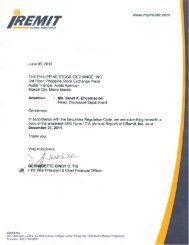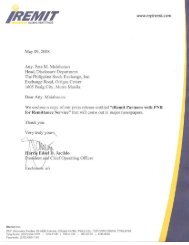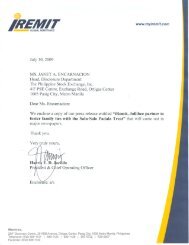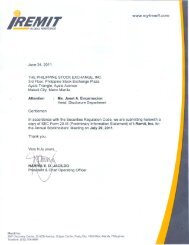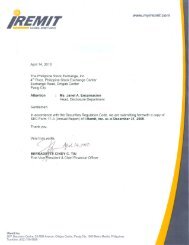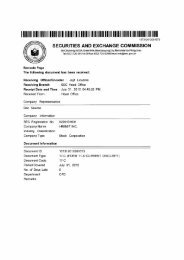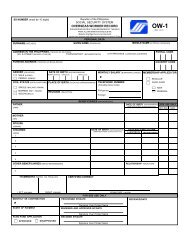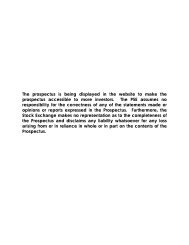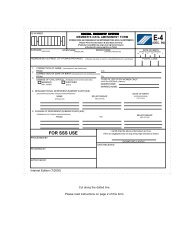SEC Form 20-IS - iRemit Global Remittance
SEC Form 20-IS - iRemit Global Remittance
SEC Form 20-IS - iRemit Global Remittance
You also want an ePaper? Increase the reach of your titles
YUMPU automatically turns print PDFs into web optimized ePapers that Google loves.
- 4 -<br />
Financial Instruments<br />
Initial Recognition<br />
Financial instruments within the scope of PAS 39 are classified as financial assets at fair value<br />
through profit or loss (FVPL), loans and receivables, held-to-maturity (HTM) investments,<br />
available-for-sale (AFS) investments, financial liabilities at FVPL and other financial liabilities.<br />
The classification of financial instruments at initial recognition depends on the purpose for which<br />
the financial instruments were acquired and their characteristics. All financial assets and financial<br />
liabilities are recognized initially at fair value plus any directly attributable cost of acquisition or<br />
issue, except in the case of financial assets and financial liabilities at FVPL. Management<br />
determines the classification of its instruments at initial recognition and, where allowed and<br />
appropriate, re-evaluates such designation at every balance sheet date.<br />
Financial instruments are recognized in the consolidated balance sheet when the Parent Company<br />
becomes a party to the contractual provisions of the instrument. In the case of regular way of<br />
purchase or sale of financial assets, recognition and derecognition, as applicable, are done using<br />
settlement date accounting. Settlement date accounting refers to (a) recognition of an asset on the<br />
day it is received by the Parent Company, and (b) the derecognition of an asset and recognition of<br />
any gain or loss on disposal on the day that it is delivered by the Parent Company. Receivables,<br />
beneficiaries and other payables, and interest-bearing loans are recognized when cash is received<br />
by the Parent Company or advanced to the borrowers/beneficiaries.<br />
The subsequent measurement bases for financial instruments depend on its classification.<br />
As of December 31, <strong>20</strong>11 and <strong>20</strong>10, the Parent Company has no financial assets and financial<br />
liabilities at FVPL, AFS investments and HTM investments.<br />
Subsequent Measurement<br />
Loans and receivables<br />
Loans and receivables are non-derivative financial assets with fixed or determinable payments that<br />
are not quoted in an active market. After initial measurement, receivables are carried at amortized<br />
cost using the effective interest method less any allowance for credit losses. Amortized cost is<br />
calculated by taking into account any discount or premium on acquisition and fees and costs that<br />
are an integral part of the effective interest rate (EIR). Gains and losses are recognized in the<br />
parent company statement of income when the receivables are derecognized or impaired, as well<br />
as through the amortization process. Receivables are classified as current assets when the Parent<br />
Company expects to realize or collect the asset within twelve months from the balance sheet date.<br />
Otherwise, these are classified as non-current assets.<br />
Classified under this category are the Parent Company’s ‘Cash and cash equivalents’, ‘Accounts<br />
receivable’, ‘Other receivables’ and refundable deposits included under ‘Other noncurrent assets’.<br />
Other financial liabilities<br />
Issued financial instruments or their components, which are not designated as at FVPL, are<br />
classified as other financial liability, where the substance of the contractual arrangement results in<br />
the Parent Company having an obligation either to deliver cash or another financial asset to the<br />
holder, or to satisfy the obligation other than by the exchange of a fixed amount of cash or another<br />
financial asset for a fixed number of its own equity shares. These include liabilities arising from<br />
operations or borrowings. The components of issued financial instruments that contain both<br />
liability and equity elements are accounted for separately, with the equity component being<br />
assigned the residual amount after deducting from the instrument as a whole the amount separately<br />
determined as the fair value of the liability component on the date of issue.<br />
*SGVMC116501*



